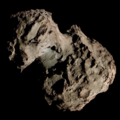 The Eclipse Comet of 1948 photographed by W. C. Braun from the McDonald Observatory on November 14, 1948 | |
| Discovery [1] | |
|---|---|
| Discovery date | 1 November 1948 |
| Designations | |
| 1948 XI, 1948l [2] | |
| Orbital characteristics [3] [4] | |
| Epoch | 10 January 1949 (JD 2432926.5) |
| Observation arc | 137 days |
| Number of observations | 17 |
| Aphelion | 3,149.44 AU |
| Perihelion | 0.1354 AU |
| Semi-major axis | 1,574.79 AU |
| Eccentricity | 0.9999 |
| Orbital period | 62,494.39 years |
| Inclination | 23.116° |
| 211.043° | |
| Argument of periapsis | 107.249° |
| Last perihelion | 27 October 1948 |
| TJupiter | 0.423 |
| Earth MOID | 0.1883 AU |
| Jupiter MOID | 1.8182 AU |
| Physical characteristics [5] [6] | |
Mean radius | 1.531 km (0.951 mi) [a] |
| Comet total magnitude (M1) | 5.5 |
| Comet nuclear magnitude (M2) | 9.0 |
| –1.0 (1948 apparition) [7] | |
The Eclipse Comet of 1948, formally known as C/1948 V1, was an especially bright comet discovered during a solar eclipse on November 1, 1948. Although there have been several comets that have been seen during solar eclipses, the Eclipse Comet of 1948 is perhaps the best-known; it was however, best viewed only from the Southern Hemisphere.
Contents
When it was first discovered during totality, it was already quite bright, at magnitude –1.0; as it was near perihelion, this was its peak brightness. [8] Its visibility during morning twilight improved as it receded outward from the Sun; it peaked near zero magnitude, and at one point displayed a tail roughly 30 degrees in length, before falling below naked eye visibility by the end of December. [8]



